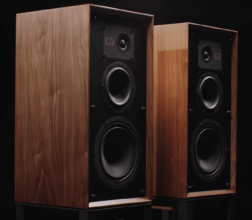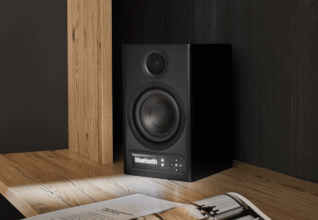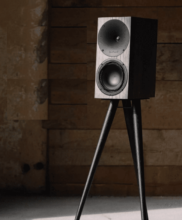Kanta No1 Review: Vive Le Focal!
French loudspeaker specialist Focal has hit the mark with its new Kanta No 1 standmount, says Jon Myles.
Experimenting with different materials for loudspeaker drive units is nothing new in the hi-fi industry. We’ve gone from damped paper to aluminium to Kevlar to all sorts of other good – and sometimes not so good – ingredients.
But Focal came up with something unusual when they decided on flax – more commonly used to make top quality linen for the fashion industry – as the main constituent in the mid/bass cones for their mid-priced range of ‘speakers.
The reasoning was sound (no pun intended) though. For flax is as stiff as carbon-fibre, matches Kevlar for rigidity yet is light with excellent self-damping properties.
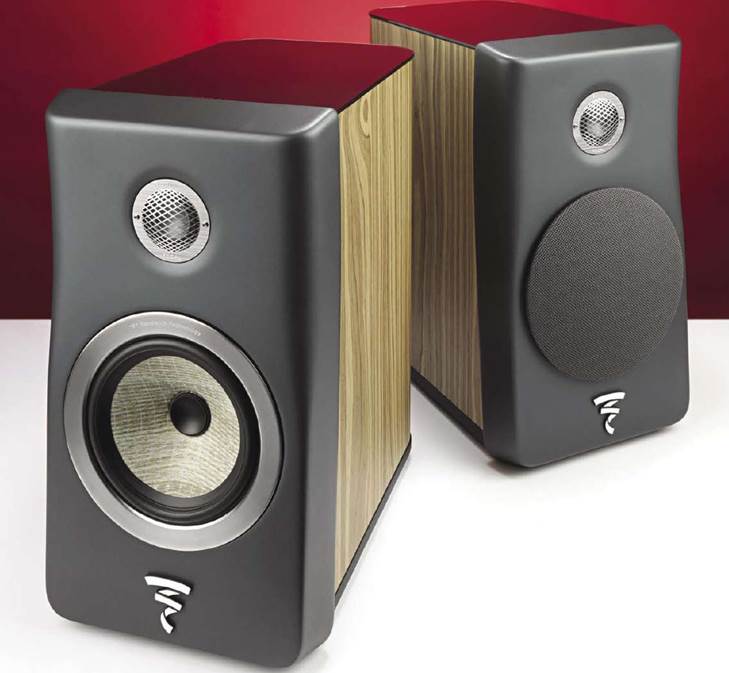
It also probably helped that Focal’s home country of France is one of the world’s largest producers of the material.
And the development chimed with the St Etienne-based manufacturer’s history of innovation – Focal being only the second company after Yamaha to use beryllium for its tweeters.
So marry flax drivers with beryllium tweeters and what do you get? The range of loudspeakers known as Kanta. I enthusiastically reviewed the Kanta No 2 floorstander last year (see Hi-Fi World issue June 2018) and now we have its little brother in the shape of the standmount Kanta No 1.
It’s obviously smaller – measuring 422mm x 234mm x 391mm (H/W/D) – but still shares the elegant lines and superb construction of its bigger brother. The main cabinet is a one- piece integrally-moulded wooden enclosure while the baffle is made from High-Density Polymer (HDP) – said to be 70% denser than MDF, 15% stiffer with 25% more damping. Its also subtly curved to help time align the drivers and extends past the edges of the main cabinet both from left to right and top to bottom.
As to those drivers: the main 6.5” mid/bass unit is composed of high-quality flax fibre enclosed by two thin layers of glass fibre allied to a 27mm inverted dome beryllium tweeter housed in a specially-designed waveguide. It also uses Focal’s IAL (Infinite Acoustic Loading) and IHL (Infinite Horn Loading) techniques to absorb rear radiation while saving space within the cabinet.
At the rear is a bass reflex port to aid low-end extension, accompanied by a single pair of ‘speaker binding posts.
“There’s an obvious synergy between the flax main driver and beryllium tweeter, the two working seamlessly together across the frequency spectrum”
All in all it’s an eye-catching package that looks decidedly more sophisticated than many box and cone standmounts on the market nowadays.
SOUND QUALITY
Having enjoyed the larger Kanta No2s immensely I was understandably eager to see how their smaller siblings would measure up. Suffice to say they share many of the larger ‘speaker’s characteristics – which is a good thing.
First, the beryllium tweeter. I’ve found some implementations of these can sound a bit edgy and harsh – but Focal have got it just right. High frequencies were clean and extended, with ringing tone.
On John Coltrane’s ‘Live At The Village Vanguard’ his saxophone soared with unbridled freedom – the cascade of notes seemingly placed high above the tops of the ‘speaker cabinets. The clarity on offer made it easy to hear when Coltrane switched from soprano to tenor saxophone.
Beneath Coltrane’s pyrotechnics the rhythm section of Reggie Workman, Jimmy Garrison and Elvin Jones sounded taut, Jones’s drums especially having decided punch.
For their size the Focal’s extract prodigious bass which not only has fulsome depth but is tuneful and fast – propelling up-tempo tracks along with verve.
The ‘speakers come with bungs for the reflex port to tune them for close to wall placement – however I found they worked best pulled further out into our large room with the port left open.
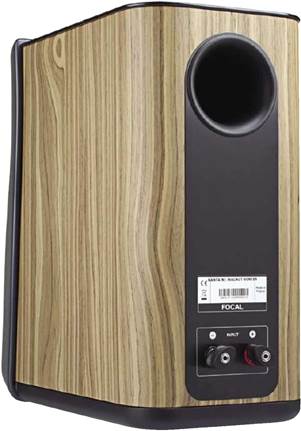
The rear of the Focals features a bass reflex port and quality loudspeaker binding posts.
There was an obvious synergy between the flax main driver and beryllium tweeter, the two working seamlessly together across the frequency spectrum.
Fed James Blake’s ‘Limit To Your Love’ – its keening vocals and sub-sonic bass making it a true test for any loudspeaker – I was immediately reaching the remote to turn the volume up, so clean and engaging was the presentation. Low registers thundered without overhang, Blake’s voice hanging in its own space between the loudspeakers; a sense of air and space let the music breathe. I didn’t get the full force of the very lowest octaves hammering into my chest. For that you’ll need much bigger loudspeakers ideally housing 12” drivers. But the Kantas still came over as big and forceful, capturing all the power and slam of the track.
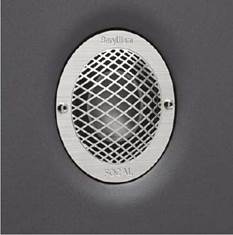
The beryllium tweeter sits inside a specially-designed waveguide for extended high frequencies.
Another plus point is that the Focals are fairly unfussy about positioning. I started with them pointing straight down the room and then experimented with some toe-in and their general character remained the same. That’s a testament to how well the tweeter assembly has been implemented – imbued as it is with a wide dispersion angle, contributing to excellent stereo imaging, music seeming to exist well clear of the loudspeaker cabinets, on a stage with width and depth.
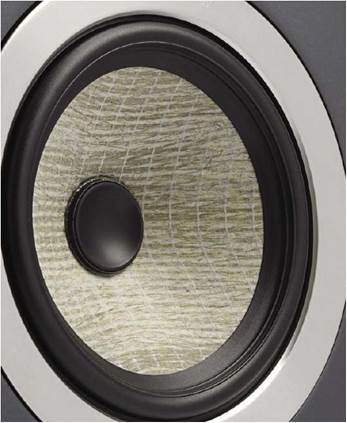
The use of woven flax gives the main driver a distinctive look that sets its apart from rival loud-speakers.
Playing Model 500s groundbreaking techno track ‘No UFOs’ the various echo effects and electronic ricochets came at me from all angles in an enveloping cascade of sound.
Playing this track I switched between a trio of amplifiers: the Copland CTA408 reviewed this issue, an Icon Audio Class A ST30se valve integrated and a trusty Creek Evolution 100A. All sounded different, the Icon Audio bringing more warmth to the sound and the Creek digging out a little extra in the bass. So whichever amplifier you pair these ‘speakers with you’ll get to hear its individual characteristics and they’ll show you just what you are paying for if you decide to upgrade the electronics.
CONCLUSION
Focal’s mix of flax and beryllium drivers is an unqualified success. Open, detailed and big-sounding, this pair of standmounts can go head-to-head with the best. Add in their striking looks and they make a superb package. Worth hearing.
MEASURED PERFORMANCE
Focal’s Kanta No 1 places an inverted dome beryllium treble unit above a natural fibre (flax) cone bass/midrange unit that crosses over at a high 5kHz our impedance plot shows. Where in the past Focal lifted treble, nowadays frequency response is almost a straight and horizontal line. Horizontality means accurate tonal balance free from heavy or light bass and, in particular, free from sharp treble and emphasis of digital distortion from CD.
FREQUENCY RESPONSE
Green – driver output
Red – port output
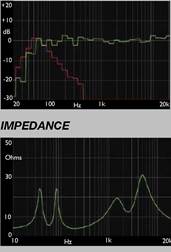
Straightness of line suggests lack of colouration, due to lack of mechanical micro-resonances in the cone material and assembly.
Bass extends smoothly down to 60Hz but is totally flat, with neither emphasis or the slow roll-down of an over-damped design purposed for wall placement. The Kanta No1 will have strong but well controlled bass when used close to a rear wall. It rolls down fast below 40Hz so will not deliver sub-sonics, but this also means it will not suffer heavy cone flap induced by LP warps. The impedance curve shows the port is narrow-tuned to 55Hz suggesting bass will be lively.
Sensitivity was as expected for a ‘speaker of the size, measuring 87dB sound pressure level (SPL) from one nominal Watt (2.8V) of input. Amplifiers around 60 Watts will deliver very high volume and powers down to 20 Watts or so will make Kanta No 1s go loud. Impedance measured 6.5 Ohms overall with pink noise, but the bass unit is 3.5 Ohms (DCR) so draws LF current.
The Kanta No 1 is impressively smooth and accurate. Bass will be firm, powerful and lively in a 16ft room. A very well engineered loudspeaker in every area.
VERDICT
Focal
www.focal.com/uk



